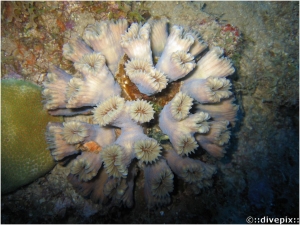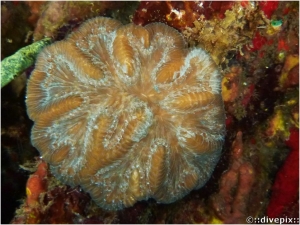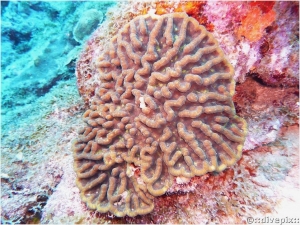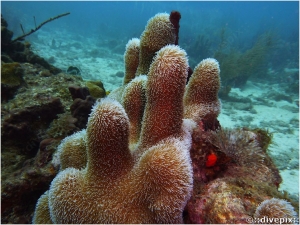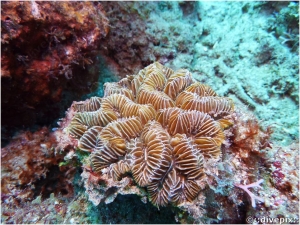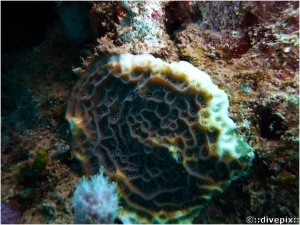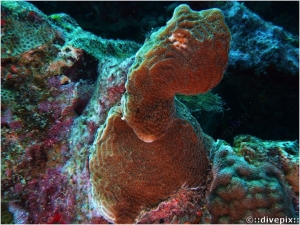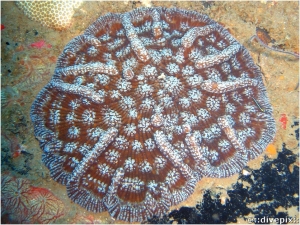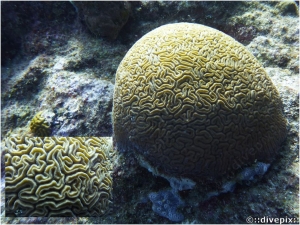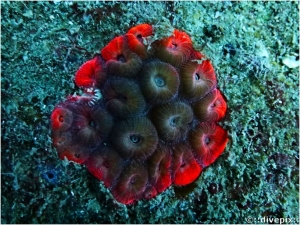




Eric H. Biass
Smooth Flower Coral
| Aspect: | Appears as a bouquet of relatively spaced oval flowers in which the individual "flowers" are the corallites. These grow on a thick, sturdy stem (theca) from a domed base of hard calcium carbonate. They can be single, but usually are twinned or tripled. |
| Population: | Very common. |
| Notable feature: | Large and conspicuous costa and septae. Transulcent polyps fully emerge at night only. |
| Environment: | Found at depths of between 5 and 40 metres. |
| Behaviour: | - |
Rose Coral-tortugas or Rose Coral
| Aspect: | Typical brain coral appearance with its meandering walls and valleys. Generally oblong and domed, colours range from beige to light grey. |
| Population: | Common. |
| Notable feature: | - |
| Environment: | Sandy bottoms. |
| Behaviour: | - |
Pillar Coral
| Aspect: | Colonies grow into single single pillar-like colonies, but can combine into tall pyramidal structures. Tips may occasionally split. |
| Population: | Abundant |
| Notable feature: | Not to be confused with Finger Coral, which can occasionally be similar in shape, but smaller, and above all with totally differently configured colonies. Pillar Coral extends comparatively long polyps. |
| Environment: | Usually on relatively horizontal sufaces, but can grown atop an older colony or coral boulder. |
| Behaviour: | - |
Maze coral, or Butterprint rose
| Aspect: | Usually a yellow or tan round-ish domed stucture of clearly separated septa, the top junctions of which form a distinct line all along the ridge they make. The goeometrical pattern of the smaller nascent colonies explains the alternative "Butterprint" designation. |
| Population: | Common. |
| Notable feature: | The vertical plates (or septa) are clearly separated. This is where the tentacles emerge from. Some of the close-ups below also show various stages of mouth openings. Under ultraviolet light (see combo picture below) the normally translucent tentacles clearly stand out. |
| Environment: | Often rests on sandy bottom or dead coral remains. |
| Behaviour: | Generally deploys its tentacles at night so profusely that it dramatically changes the overal aspect of the colony. This is also a time at which the "grilled" mouths become very visible. |
Low Relief Lettuce Coral
| Aspect: | At first looks like a heavily veined structure. Closer look reveals deeply encrusted coralites looking like a array of volcanoes. Generally brown. |
| Population: | Common. |
| Notable feature: | Very steep septa. |
| Environment: | Particularly occurs on the walls of protected "canyons" at depths of about 10 metres. |
| Behaviour: | - |
Lettuce Coral
| Aspect: | Hard encrusting structure made of ridges and valley seemingly looking like differently sized cells randomly disposed on the substrate, which can be flat or of convoluted shape. Light to dark brown. |
| Population: | Common. |
| Notable feature: | Ridges have a distinctive ogival shaped section. |
| Environment: | Grows on any solid structure in open waters, particularly on vertical substrates. |
| Behaviour: | - |
Knobby Cactus Coral
| Aspect: | Thus named due to the studs - or "knobs" - that ornate this species of cactus coral. The species encrusts base surfaces, but can also expand in an overhanging manner. It tends to grow in a less tidy circular manner when it exceeds a diameter of about 30 centimetres and, as some of the pictures herewith show, knobs tend to replace radial ridges in the central area at more important depths. |
| Population: | Common. |
| Notable feature: | Like Ridged Cactus Coral (q.v.) this pie-shaped coral plate is surrounded by a ridge, from which more ridges extend radially towards the centre. In some cases the slightly raised corallites can feature very contrasting colours like the bright green over brown in one of the specimens shown below, and at the centre of which the mouths can be clearly seen. |
| Environment: | Near or at base of rock or coral boulders, starting at 10 metres down to 40 metres. |
| Behaviour: | - |
Grooved Brain Coral
| Aspect: |
Generally hemispherical mass with deeply gouged valleys spearated by steep ridges. However where the top of these ridges normally feature narrow or relatively broader separation lines between opposing septa (like most other brain corals, see Symmetrical Brain Coral or Boulder Brain Coral) they can here feature very wide separation furrows - the grooves - as exemplified by one of the photos shown below, and in particular its red-dotted enlargement. Indeed some specimens can grow unusually wide-angled grooves between separating ridges, but in fact the polyps live in the narrow valleys where their mouths are fed by the many tentacles housed between the septa (the vertical plates). |
| Population: | Common. |
| Notable feature: | Resembles a labyrinth (hence scientific designation).Colour is usually yellow to tan, but can fade into a light green |
| Environment: | Grows on solid structures in open and medium-depth to shallow waters. |
| Behaviour: | Appearance can change dramatically at night when polyp tentacles are out. |
Great Star Coral
| Aspect: | Colonies can grow into massive mounds (hence older Montastraea designation given by ), although eventual size depends on available development base. Of all the former Montrastaea species, cavernosa appears to feature the most prominent and largest corallites (up to 10mm in diameter) with the tightest array of corallites. Corallites also appear to feature the most cavernous mouth cavities. The former Montrastaea species included Montrastaea annularis, faveolata and franksi. They are all now known as Orbicella annularis, faveolata and franksi. Only Cavernosa remained Montastraea. |
| Population: | Abundant. |
| Notable feature: |
Colours, including brown (most common in Western Guadeloupe), green and sometimes grey - depend on zooxanthellae types which, depending on content of particular proteins, can even cause red fluorecence as seen in title photograph - in total absence of special fluo lights. Zooxanthellae are microscopic photosynthetic algae that live in symbiosis with corals. The latter provide shelter in exchange of which the zooxanthellae supply certain nutriments (including glucose and aminoacids relutling from photosynthesis) that enable them to eventually produce the calcium carbonate used to form their structure. |
| Environment: | Depths of between a few metres to 40 metres. |
| Behaviour: | Polyps extend at night, revealing a variety of colours, including bright greens. |



